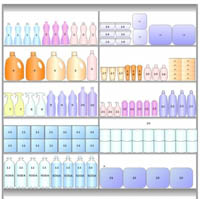What Are SRP and RRP?
 In the retail universe, SRP and RRP mean respectively Shelf-Ready Packaging and Retail-Ready Packaging.
In the retail universe, SRP and RRP mean respectively Shelf-Ready Packaging and Retail-Ready Packaging.
SRP or RRP is “a product that arrives at retail in a ready merchandised unit which is easy to identify, easy to open, can easily be put onto the shelf and recycled or disposed of when empty, allowing an optimization of shelf replenishment and enhancing visibility… covers all types of packaging which goes into the retail outlet, including promotional displays, pallets, trays, etc…
The main focus is to increase on shelf availability and the potential for end use packaging to add value throughout the supply chain – to the manufacturer, retailer and consumer. RRP provides benefits well beyond the product’s journey from stock room to shelf.
The best players in the SRP & RRP are the European hard discounters and partially the drugstores and lately we have seen many classical retailers adapting this packaging technique to optimize their daily operational cost.
It looks obvious that not all categories and sub-categories will manage easily to offer their assortment in SRP or RRP, but in the working categories, products will definitely have:
• Better availability
• Better rotation of stock & reduced product wastage
• Improved blocking & branding on shelf
• Improved safety
• Smarter way to replenish the shelf

Partial sources: The Packaging Association and Store Brands Decisions

 All consumer markets of industrialized countries and now developing countries are characterized by great diversity of supply and an increasing complication in the process of products assortments by retailers. This major increase in the number of products on the shelves, which may also interfere in some cases with the store offer but also in the shopping process of consumers, has led the retailers to consider setting up a new approach to their assortment and relying on a more active collaboration with the suppliers.
All consumer markets of industrialized countries and now developing countries are characterized by great diversity of supply and an increasing complication in the process of products assortments by retailers. This major increase in the number of products on the shelves, which may also interfere in some cases with the store offer but also in the shopping process of consumers, has led the retailers to consider setting up a new approach to their assortment and relying on a more active collaboration with the suppliers.